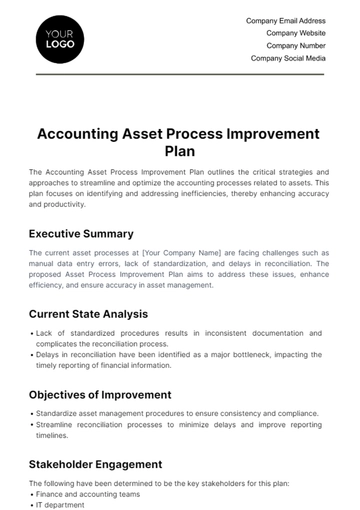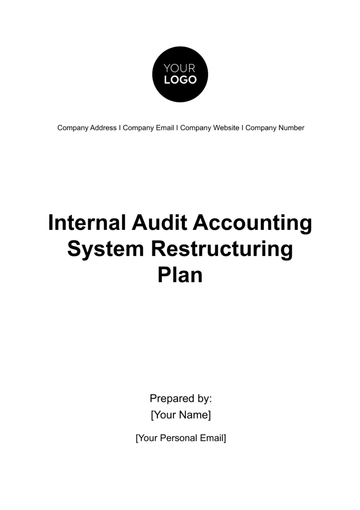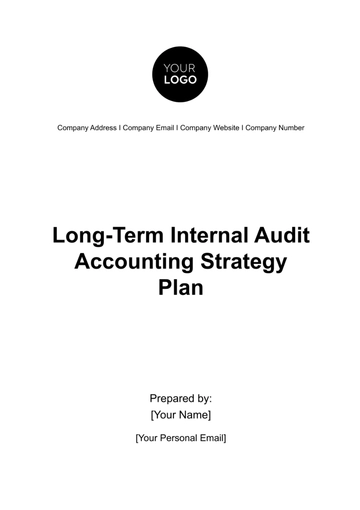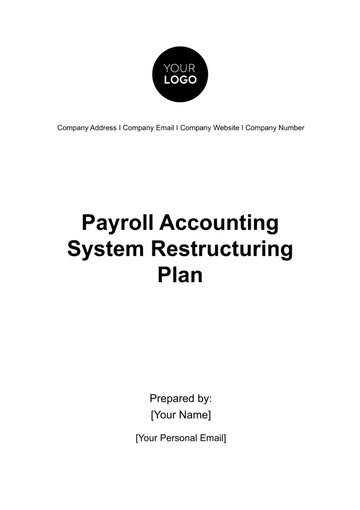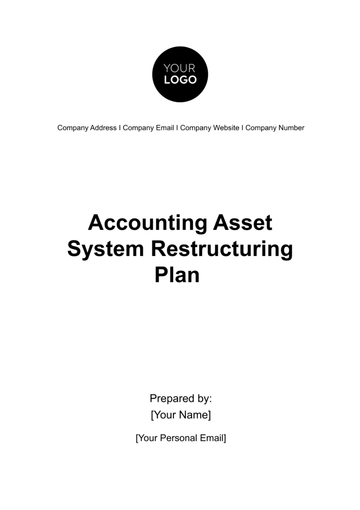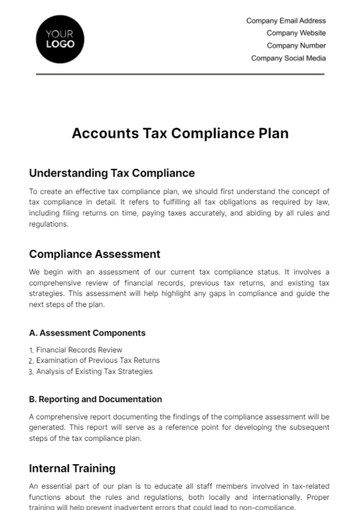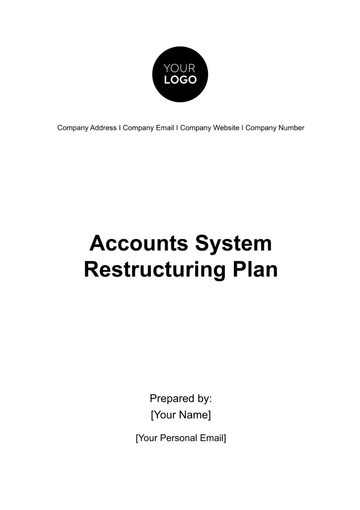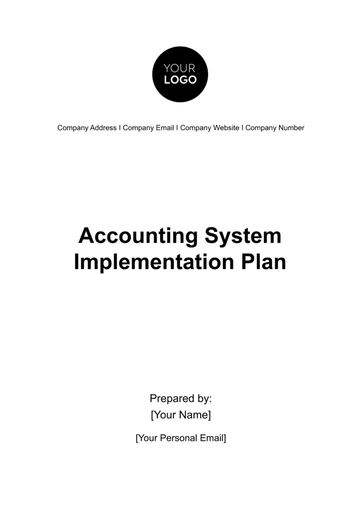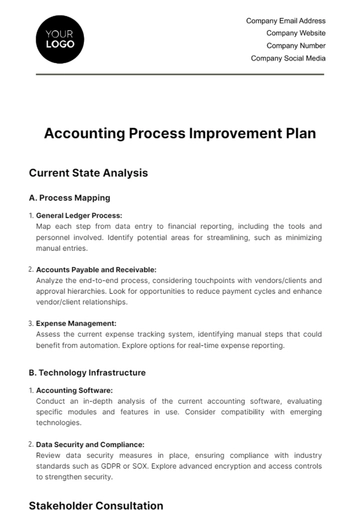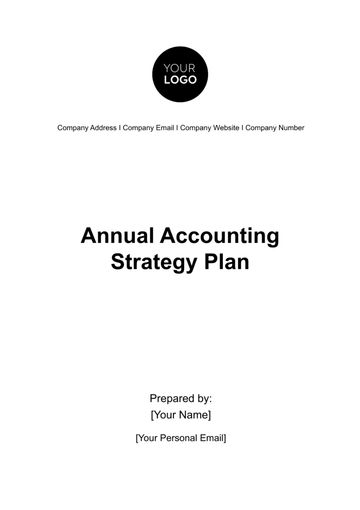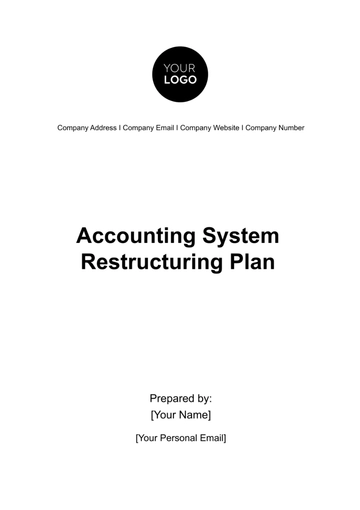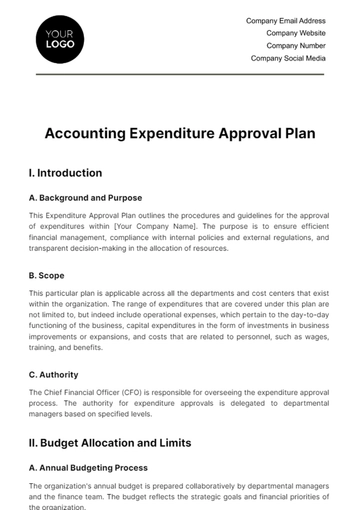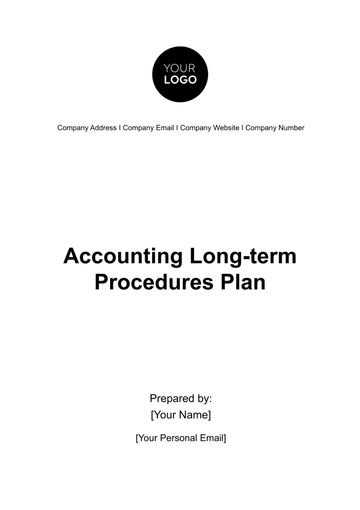Free Accounting System Implementation Plan
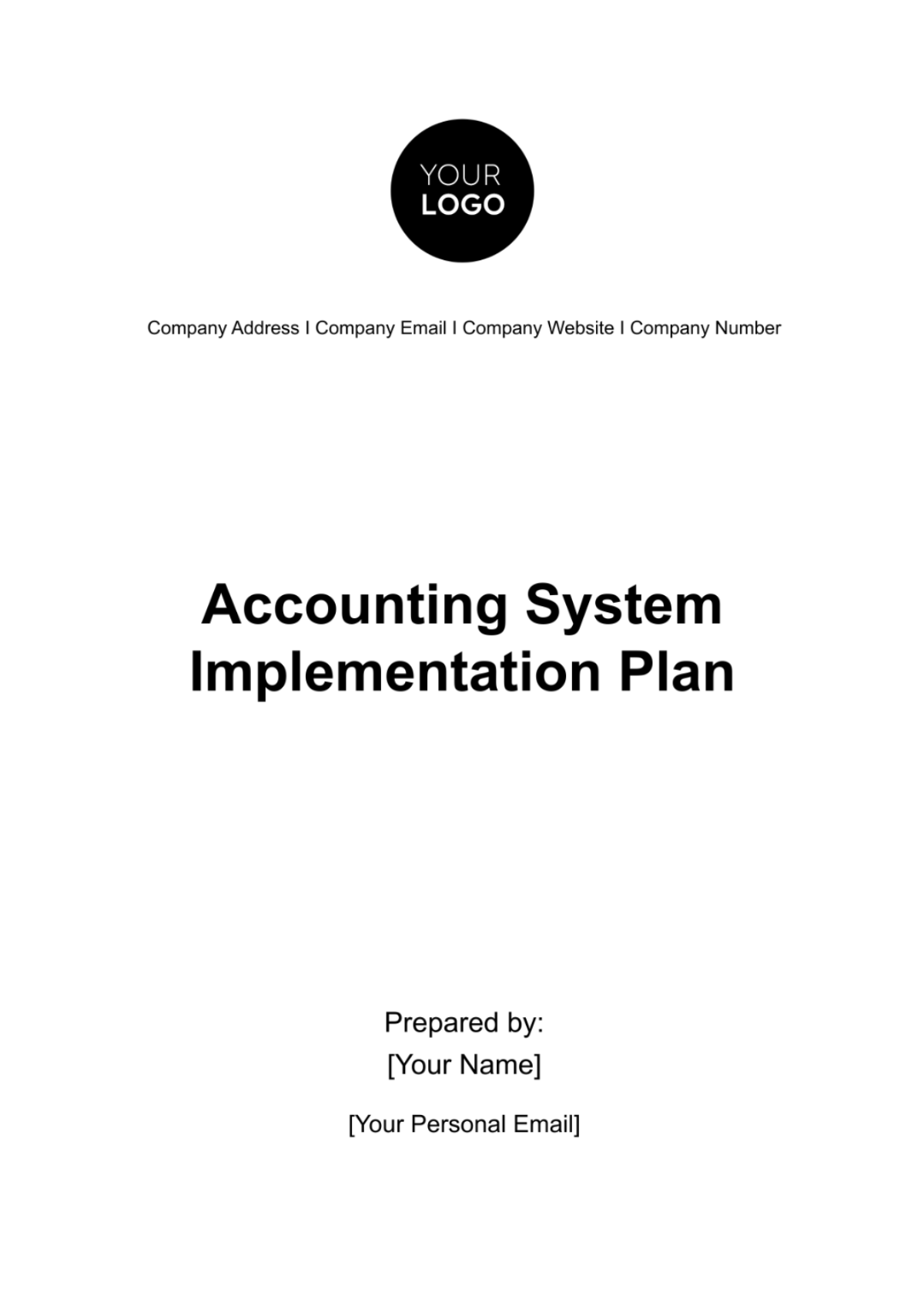
I. Executive Summary
The Accounting System Implementation Plan is a strategic roadmap designed to facilitate the seamless transition from our current accounting system to a more sophisticated and integrated solution. This comprehensive plan aims to address inefficiencies in our financial processes, elevate reporting accuracy, and ensure compliance with evolving regulatory standards. The successful implementation of this new system will not only optimize day-to-day financial operations but also empower the organization with enhanced analytical capabilities, fostering data-driven decision-making.
II. Introduction
A. Background:
With a legacy accounting system in place for over a decade, the need for a robust and modern solution has become evident. The existing system, while functional, struggles to keep pace with the complexity of our expanding financial landscape. The Accounting System Implementation Plan responds to this challenge by ushering in a new era of efficiency, accuracy, and compliance.
B. Objectives:
The primary objectives of this implementation are to streamline financial processes, reduce error rates, and provide a scalable platform for future growth. By implementing this new system, we aim to achieve enhanced reporting capabilities, improved data integrity, and the agility to adapt to changing business needs.
III. Project Scope and Deliverables
A. Scope Definition:
The scope of this implementation includes the deployment of the General Ledger, Accounts Payable, Accounts Receivable, and Cash Management modules. While customization options are available, this plan focuses on implementing the standard features of the selected accounting software. Any potential customization beyond the standard modules is excluded from the current scope.
B. Deliverables:
The implementation of the system is carried out using a phased approach, which is beneficial in ensuring that every milestone we achieve brings us one step closer to a fully functional and operational system, further optimized to operate at peak performance. As we head towards this goal, we have a determined set of key deliverables which are instrumental for the success of the project. These imperative deliverables include the successful installation of the necessary software, something which requires expertise and precision. Moreover, another deliverable is the accurate migration of data, a process that demands meticulousness to ensure no crucial data is lost or compromised during the transition. Furthermore, another aspect of our deliverables is the completion of user training. This training is designed not only to educate the users about how to use the new system but also to troubleshoot any minor issues they may encounter. Lastly, our deliverables include ensuring a smooth transition during the actual system go-live. This transition is crucially important as it means shifting from the old system to the new one with minimal disturbance or downtime, ensuring business continuity and lessening the negative impact on productivity. These deliverables, when met efficiently, ensure the successful implementation and operation of the new system.
IV. Project Team
A. Roles and Responsibilities:
The project team is composed of key individuals with distinct roles. The Project Manager oversees the entire project, ensuring effective communication and coordination. Financial Analysts gather requirements, conduct data analysis, and participate in system testing. IT Specialists focus on software installation, configuration, and technical support, while the Training Coordinator is responsible for developing and executing user training programs.
Role | Responsibilities |
|---|---|
Project Manager | Overall project oversight, coordination, and communication |
Financial Analysts | Requirements gathering, data analysis, and system testing |
IT Specialists | Software installation, configuration, and technical support |
Training Coordinator | Development and execution of user training programs |
B. Organizational Structure:
To maintain an efficient reporting structure, the project team will report directly to the Chief Financial Officer (CFO). Regular weekly status meetings will be conducted to discuss progress, address concerns, and ensure the project stays on track.
V. Project Timeline and Milestones
A. Gantt Chart:
A Gantt chart visually represents the project timeline, illustrating the interconnectedness of tasks and milestones. This dynamic tool will provide a clear overview of the project's progress and help manage dependencies efficiently.
B. Milestone Details:
The project is divided into four main phases, each culminating in a significant milestone. The successful completion of these milestones, including software installation, data migration, user training, and system go-live, is contingent on the preceding phase's success.
Milestone | Phase | Details and Deliverables | Dependencies |
|---|---|---|---|
1 | Phase 1 | Software installation and basic configurations | N/A |
2 | Phase 2 | Data migration and validation | Completion of Phase 1 |
3 | Phase 3 | User training and competency assessments | Completion of Phase 2 |
4 | Phase 4 | System go-live and post-implementation support | Completion of Phase 3 |
VI. Budget and Resource Allocation
A. Budget Estimate:
A detailed breakdown of estimated costs includes $50,000 for software, $20,000 for hardware, $15,000 for training, $30,000 for consulting services, and a $10,000 contingency fund. The total budget of $125,000 is allocated judiciously to ensure the project's success without unnecessary expenditures.
Category | Estimated Cost ($) |
|---|---|
Software | 50,000 |
Hardware | 20,000 |
Training | 15,000 |
Consulting Services | 30,000 |
Contingency | 10,000 |
Total | 125,000 |
B. Resource Allocation:
Human resources are allocated strategically to ensure the right expertise at each stage. The Project Manager takes up 50% of the effort, Financial Analysts contribute 30%, IT Specialists devote 15%, and the Training Coordinator focuses on 5%, ensuring a balanced distribution of responsibilities across the team.
Role | Allocation |
|---|---|
Project Manager | 50% |
Financial Analysts | 30% |
IT Specialists | 15% |
Training Coordinator | 5% |
VII. Risk Assessment and Mitigation
A. Identification of Risks:
A thorough risk assessment has been conducted to identify potential challenges. Risks include data migration issues, resistance to change, and unforeseen technical glitches. By categorizing risks based on severity and likelihood, we have gained insights into potential obstacles that may arise during the implementation process.
B. Mitigation Strategies:
To mitigate these risks, we have developed comprehensive strategies. Data migration challenges will be addressed through meticulous planning and validation processes. Resistance to change will be managed through effective communication and change management strategies. Technical glitches will be minimized through rigorous testing procedures and ongoing technical support.
VIII. Data Migration Plan
A. Data Assessment:
A detailed assessment of existing data has been conducted to identify any inconsistencies or anomalies. This phase includes data cleansing and preparation to ensure that data is in optimal condition for migration.
B. Migration Strategy:
The migration plan outlines a phased approach to transferring data to the new system. Rigorous validation processes will be employed to verify data accuracy and integrity at each step. Contingency plans are in place to address any issues that may arise during the migration process.
IX. Training Plan
A. Training Needs Analysis:
A thorough analysis of training needs has been conducted to identify user groups and their specific requirements. Skill gaps have been identified, ensuring that training programs address the unique needs of different departments.
B. Training Program:
The training program is designed to cover software functionalities, new processes, and best practices. Training materials include manuals, video tutorials, and hands-on sessions. A training schedule has been developed, considering different user groups and their availability.
X. Testing Procedures
A. Test Plan:
A comprehensive test plan has been developed, outlining criteria for testing success and various types of testing. This includes system integration testing, user acceptance testing, and performance testing to ensure that the new accounting system functions seamlessly.
B. Testing Schedule:
A detailed schedule for testing activities has been established, allocating resources and responsibilities. This ensures that each testing phase is conducted thoroughly and that identified issues are promptly addressed before moving to the next stage.
XI. Communication Plan
A. Stakeholder Communication:
A stakeholder communication plan has been developed to keep all relevant parties informed about the progress of the implementation. Regular updates will be provided through meetings, emails, and progress reports. Feedback mechanisms have been established to address concerns and suggestions.
B. Internal Communication:
Internal communication within the project team is crucial for efficient collaboration. Regular team meetings, status reports, and a centralized communication channel will ensure that everyone is aligned with project goals and informed about any changes or updates.
XII. Go-Live and Post-Implementation Support
A. Go-Live Plan:
The go-live plan outlines the strategy and timeline for transitioning to the new system. This includes a phased approach to minimize disruptions, a rollback plan in case of critical issues, and a communication strategy to keep users informed.
B. Post-Implementation Support:
Post-implementation support mechanisms are in place to address any issues that may arise after the system goes live. This includes a dedicated support team, regular check-ins with end-users, and a helpdesk system to facilitate quick issue resolution.
XIII. Documentation
A. User Manuals:
Comprehensive user manuals have been developed to guide end-users through the functionalities of the new accounting system. These manuals cover step-by-step procedures, troubleshooting guides, and FAQs to empower users with the knowledge needed for seamless system navigation.
B. Technical Documentation:
Detailed technical documentation is available for administrators and IT support. This documentation includes system configurations, settings, and maintenance procedures. This resource ensures that the IT team has the necessary information to manage and support the system effectively.
XIV. Change Management
A. Change Communication:
Change management strategies have been implemented to address potential resistance to the new system. Regular communication regarding the benefits of the change, training opportunities, and the support available will be disseminated to all stakeholders. This proactive approach aims to foster a positive attitude towards the upcoming changes.
B. Adoption and Training:
To facilitate smooth adoption, a phased training approach has been incorporated into the change management plan. This involves ongoing training sessions, workshops, and support forums to ensure that end-users feel confident and competent with the new accounting system.
XV. Approval and Sign-Off
A. Stakeholder Sign-Off:
Stakeholders, including executive management and key users, will be provided with the opportunity to review and sign off on the final implementation plan. Their endorsement signifies acknowledgment and acceptance of the proposed strategies, timelines, and resource allocations.
B. Project Team Approval:
The project team will review and approve the detailed implementation plan before proceeding to the next stages. This internal approval process ensures alignment within the team and provides a collective commitment to the successful execution of the plan.
- 100% Customizable, free editor
- Access 1 Million+ Templates, photo’s & graphics
- Download or share as a template
- Click and replace photos, graphics, text, backgrounds
- Resize, crop, AI write & more
- Access advanced editor
Elevate your accounting processes with our Accounting System Implementation Plan, available on Template.net. This editable and customizable template, enhanced by our AI Editor Tool, offers a comprehensive roadmap for seamless transitions. Streamline your financial operations, mitigate risks, and ensure compliance. Unlock efficiency effortlessly with a tailored plan that adapts to your organization's unique needs.
You may also like
- Finance Plan
- Construction Plan
- Sales Plan
- Development Plan
- Career Plan
- Budget Plan
- HR Plan
- Education Plan
- Transition Plan
- Work Plan
- Training Plan
- Communication Plan
- Operation Plan
- Health And Safety Plan
- Strategy Plan
- Professional Development Plan
- Advertising Plan
- Risk Management Plan
- Restaurant Plan
- School Plan
- Nursing Home Patient Care Plan
- Nursing Care Plan
- Plan Event
- Startup Plan
- Social Media Plan
- Staffing Plan
- Annual Plan
- Content Plan
- Payment Plan
- Implementation Plan
- Hotel Plan
- Workout Plan
- Accounting Plan
- Campaign Plan
- Essay Plan
- 30 60 90 Day Plan
- Research Plan
- Recruitment Plan
- 90 Day Plan
- Quarterly Plan
- Emergency Plan
- 5 Year Plan
- Gym Plan
- Personal Plan
- IT and Software Plan
- Treatment Plan
- Real Estate Plan
- Law Firm Plan
- Healthcare Plan
- Improvement Plan
- Media Plan
- 5 Year Business Plan
- Learning Plan
- Marketing Campaign Plan
- Travel Agency Plan
- Cleaning Services Plan
- Interior Design Plan
- Performance Plan
- PR Plan
- Birth Plan
- Life Plan
- SEO Plan
- Disaster Recovery Plan
- Continuity Plan
- Launch Plan
- Legal Plan
- Behavior Plan
- Performance Improvement Plan
- Salon Plan
- Security Plan
- Security Management Plan
- Employee Development Plan
- Quality Plan
- Service Improvement Plan
- Growth Plan
- Incident Response Plan
- Basketball Plan
- Emergency Action Plan
- Product Launch Plan
- Spa Plan
- Employee Training Plan
- Data Analysis Plan
- Employee Action Plan
- Territory Plan
- Audit Plan
- Classroom Plan
- Activity Plan
- Parenting Plan
- Care Plan
- Project Execution Plan
- Exercise Plan
- Internship Plan
- Software Development Plan
- Continuous Improvement Plan
- Leave Plan
- 90 Day Sales Plan
- Advertising Agency Plan
- Employee Transition Plan
- Smart Action Plan
- Workplace Safety Plan
- Behavior Change Plan
- Contingency Plan
- Continuity of Operations Plan
- Health Plan
- Quality Control Plan
- Self Plan
- Sports Development Plan
- Change Management Plan
- Ecommerce Plan
- Personal Financial Plan
- Process Improvement Plan
- 30-60-90 Day Sales Plan
- Crisis Management Plan
- Engagement Plan
- Execution Plan
- Pandemic Plan
- Quality Assurance Plan
- Service Continuity Plan
- Agile Project Plan
- Fundraising Plan
- Job Transition Plan
- Asset Maintenance Plan
- Maintenance Plan
- Software Test Plan
- Staff Training and Development Plan
- 3 Year Plan
- Brand Activation Plan
- Release Plan
- Resource Plan
- Risk Mitigation Plan
- Teacher Plan
- 30 60 90 Day Plan for New Manager
- Food Safety Plan
- Food Truck Plan
- Hiring Plan
- Quality Management Plan
- Wellness Plan
- Behavior Intervention Plan
- Bonus Plan
- Investment Plan
- Maternity Leave Plan
- Pandemic Response Plan
- Succession Planning
- Coaching Plan
- Configuration Management Plan
- Remote Work Plan
- Self Care Plan
- Teaching Plan
- 100-Day Plan
- HACCP Plan
- Student Plan
- Sustainability Plan
- 30 60 90 Day Plan for Interview
- Access Plan
- Site Specific Safety Plan



